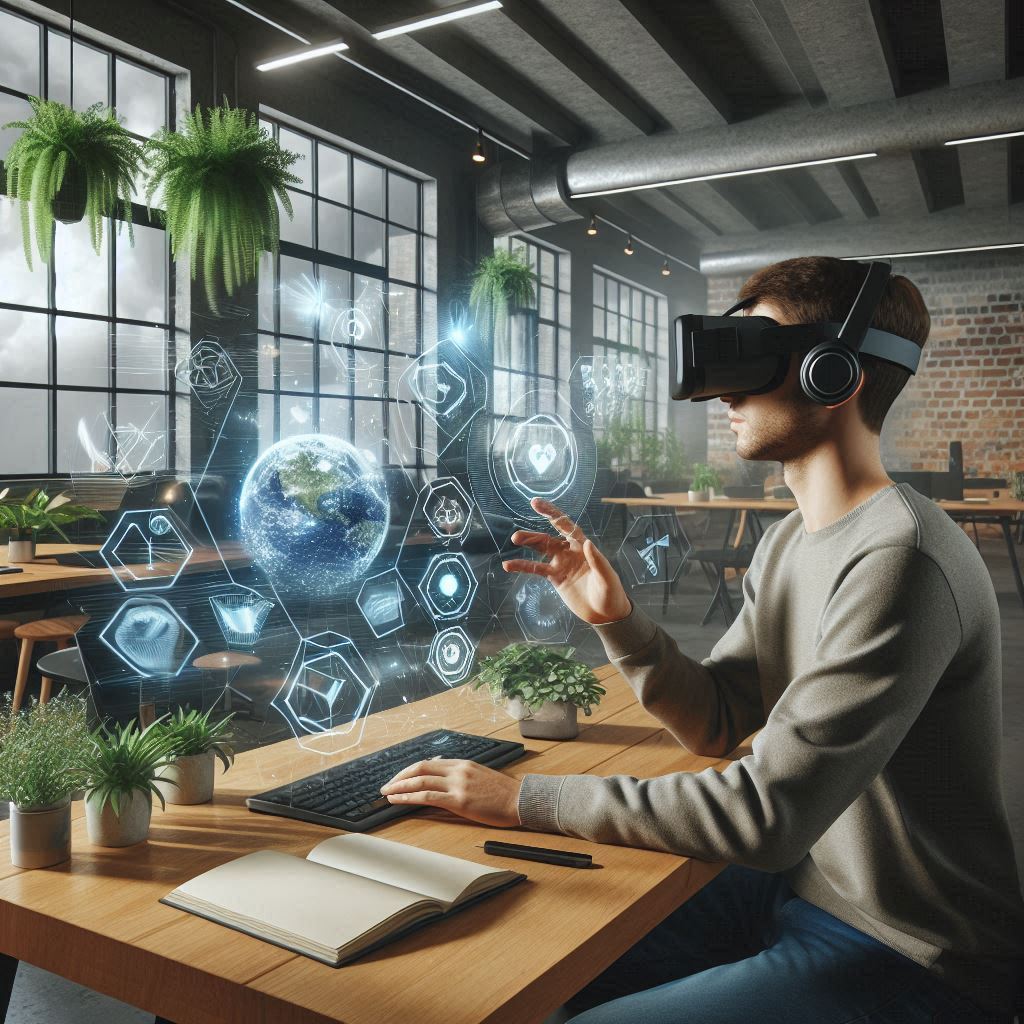How to Set Up a Mixed Reality Workspace for Remote Teams: A Step-by-Step Guide

Introduction: Understanding the Mixed Reality Workspace
A Mixed Reality Workspace merges the physical and virtual worlds, creating an immersive environment where remote teams can collaborate seamlessly. As remote work becomes the norm, companies seek innovative solutions to keep their teams connected and productive. A Mixed Reality Workspace can bridge the gap between physical presence and virtual interaction, allowing remote team members to experience a shared space despite being miles apart. This guide will walk you through setting up a Mixed Reality Workspace, ensuring your team stays engaged and effective.

Mixed Reality Workspace
Why Choose a Mixed Reality Workspace for Remote Teams?
Adopting a Mixed Reality Workspace offers numerous benefits, including enhanced collaboration, improved productivity, and a more engaging work environment. Unlike traditional video conferencing, a Mixed Reality Workspace allows team members to interact with 3D models, virtual objects, and shared digital spaces, providing a sense of presence that goes beyond flat screens. This technology can be particularly beneficial for remote teams working in fields such as architecture, design, engineering, and more, where spatial awareness is key to effective communication.
Step 1: Selecting the Right Mixed Reality Platform
The first step in setting up a Mixed Reality Workspace for your remote team is selecting a suitable platform. There are several platforms to choose from, including Microsoft Mesh, Spatial, and Horizon Workrooms. These platforms offer various features like 3D object manipulation, virtual whiteboards, and real-time collaboration. When selecting a platform, consider factors such as ease of use, compatibility with your team’s existing hardware, and the level of customization it allows. A robust Mixed Reality Workspace platform can significantly enhance the user experience and streamline the transition from a conventional workspace.
Step 2: Investing in Suitable Hardware for a Mixed Reality Workspace
To effectively create a Mixed Reality Workspace, investing in the right hardware is crucial. Devices such as VR headsets, AR glasses, and compatible computers are essential to deliver a seamless experience. Leading VR headsets like the Oculus Quest 2, HTC Vive, and Microsoft HoloLens provide immersive visuals and comfortable wearability. Additionally, ensure your computers have the processing power and graphics capabilities to support the mixed reality software. Proper hardware will ensure your Mixed Reality Workspace runs smoothly and offers a high-quality experience to all users.
Step 3: Designing the Virtual Layout of Your Mixed Reality Workspace
A well-designed Mixed Reality Workspace layout enhances the usability and comfort of remote teams. Start by creating virtual meeting rooms, breakout spaces, and areas for presentations. Think about the kind of interactions your team will have and design the workspace to facilitate these activities. For instance, include virtual whiteboards for brainstorming sessions or 3D models for product design reviews. The flexibility of a Mixed Reality Workspace allows you to create environments that suit the specific needs of your team, promoting better engagement and collaboration.
Step 4: Ensuring a Stable and High-Speed Internet Connection
A Mixed Reality Workspace relies heavily on a stable, high-speed internet connection. For seamless interactions, it’s essential that all participants have access to reliable internet with sufficient bandwidth to support virtual reality content. Consider setting up a dedicated network or upgrading to fiber-optic internet to ensure the best experience. A strong connection prevents lag, ensuring that your remote team can interact smoothly within the Mixed Reality Workspace without disruptions.
Step 5: Training Your Team to Use the Mixed Reality Workspace
The success of a Mixed Reality Workspace depends not just on the technology but on how well your team can use it. Conduct training sessions to familiarize your remote team members with the new platform. Focus on guiding them through basic navigation, using collaborative tools, and troubleshooting common issues. Provide user manuals and schedule follow-up training sessions to address any challenges they may face. A well-trained team can fully leverage the potential of a Mixed Reality Workspace, leading to better collaboration and productivity.
Step 6: Establishing Guidelines and Best Practices for a Mixed Reality Workspace
Setting up a Mixed Reality Workspace also involves creating best practices and guidelines to ensure smooth operation. Establish rules for virtual meeting etiquette, time management, and data security. Make sure that each team member understands how to maintain professionalism, even in a virtual environment. By creating clear guidelines, you help your team stay focused and productive, making the most of the Mixed Reality Workspace. Watch more detailed articles about mixed reality Blogs.

After setting up your Mixed Reality Workspace, it’s important to continuously evaluate its effectiveness and optimize as needed. Gather feedback from your remote team members about their experiences with the virtual environment. Identify any technical issues, user interface challenges, or features that could be improved. Regularly update the software and explore new tools to enhance functionality.
Conclusion: Enhancing Remote Collaboration with a Mixed Reality Workspace
Implementing a Mixed Reality Workspace can transform the way your remote team collaborates and interacts. By creating an environment where virtual and physical elements blend seamlessly, you can replicate the in-office experience while enjoying the flexibility of remote work. Following this step-by-step guide will help you set up a Mixed Reality Workspace that not only meets the needs of your team but also enhances their productivity and engagement. Embrace this innovative approach and take your remote team’s collaboration to the next level.




Your article helped me a lot, is there any more related content? Thanks!
I don’t think the title of your article matches the content lol. Just kidding, mainly because I had some doubts after reading the article.
Can you be more specific about the content of your article? After reading it, I still have some doubts. Hope you can help me.
Your article helped me a lot, is there any more related content? Thanks!
Can you be more specific about the content of your article? After reading it, I still have some doubts. Hope you can help me.
Thank you for your sharing. I am worried that I lack creative ideas. It is your article that makes me full of hope. Thank you. But, I have a question, can you help me?
Thanks for sharing. I read many of your blog posts, cool, your blog is very good. https://accounts.binance.info/register?ref=P9L9FQKY
Thanks for sharing. I read many of your blog posts, cool, your blog is very good.
Your point of view caught my eye and was very interesting. Thanks. I have a question for you.
Can you be more specific about the content of your article? After reading it, I still have some doubts. Hope you can help me.
Thank you for your sharing. I am worried that I lack creative ideas. It is your article that makes me full of hope. Thank you. But, I have a question, can you help me?
Thank you for your sharing. I am worried that I lack creative ideas. It is your article that makes me full of hope. Thank you. But, I have a question, can you help me?
Thanks for sharing. I read many of your blog posts, cool, your blog is very good.
Your article helped me a lot, is there any more related content? Thanks!
Well written and inspiring! Keep up the great work.
Thanks for sharing! I learned something new today.
Thank you for your sharing. I am worried that I lack creative ideas. It is your article that makes me full of hope. Thank you. But, I have a question, can you help me?
Thank you for your sharing. I am worried that I lack creative ideas. It is your article that makes me full of hope. Thank you. But, I have a question, can you help me?
Thank you for your sharing. I am worried that I lack creative ideas. It is your article that makes me full of hope. Thank you. But, I have a question, can you help me?
Great insights! This really gave me a new perspective. Thanks for sharing.
Thanks for sharing. I read many of your blog posts, cool, your blog is very good.
Your article helped me a lot, is there any more related content? Thanks!
Can you be more specific about the content of your article? After reading it, I still have some doubts. Hope you can help me. https://accounts.binance.com/ka-GE/register?ref=RQUR4BEO
I don’t think the title of your article matches the content lol. Just kidding, mainly because I had some doubts after reading the article.